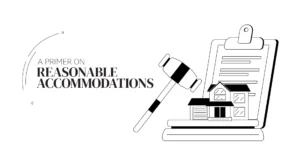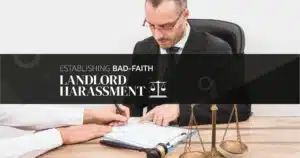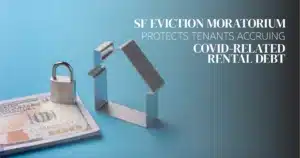One of my clients—let’s call her Nia—had lived in the same rent-controlled apartment for 14 years. One day, she found a 60-day notice taped to her door. Her building was “under renovation,” the landlord claimed. Convenient timing. Rent control had capped her payments for years. And now, with the market surging, her landlord wanted her out.
She called me in a panic, asking “What are the rights of a long-term tenant in California?”
I hear this question constantly. And for good reason. Tenants like Nia pour their lives into homes, only to face shady evictions, rent spikes, and legal threats.
If this sounds familiar, don’t worry. The law is on your side—if you know where to look.
Let’s break it down.
Can a Landlord Evict a Long-Term Tenant in California?
Short answer: yes, but only with just cause.
Since AB 1482 became law, landlords can’t toss tenants out on a whim. No more “we need the unit back” with nothing to back it. No more “renovation” claims without proof. And if you’re a long-term tenant, the law leans hard in your favor.
Still, some landlords try to get slick. And when they do? Courts strike back.
Let’s talk about Barrington Plaza—a case that shook Los Angeles in 2024.
More than 100 tenants at a rent-stabilized high-rise in Brentwood were slapped with eviction notices by corporate landlord Douglas Emmett, Inc. Their excuse? They needed to install a fire sprinkler system. They leaned on the Ellis Act, a California law meant to let landlords “exit” the rental business.
But there was a catch. The tenants called it what it was—a stunt. The landlord never planned to leave the rental game permanently. They intended to renovate, then re-rent the same units later—at higher rates.
Tenants banded together, formed a legal wall, and took their case to court.
Judge H. Jay Ford didn’t buy the landlord’s story. He ruled that under the Ellis Act, landlords must have no intent to re-rent the units in the future. And here? The landlord had already mapped out renovations, upgrades, and a return to business in 3 to 5 years. That’s not exiting. That’s flipping the script for profit.
The court shut the evictions down—hard.
Why does this matter? Because it stops a dangerous trend in its tracks. If Barrington’s landlord had won, others would’ve copied the move—fake an “exit,” push tenants out, and cash in later.
Instead, this ruling became a tenant rights milestone. It proved that long-term renters aren’t sitting ducks. Judges want real reasons—not smoke, mirrors, and construction permits.
So here’s the deal: If you’ve paid rent, followed your lease, and kept your end of the bargain—you’re not easy to remove. Not legally. Not quietly.
And if they try? You fight. We’ll help.
Valid Legal Grounds for Eviction?
- Non-payment of rent
- Criminal activity or lease violations
- Owner move-in (with strict rules)
- Substantial renovations (backed by permits + relocation payments)
Landlords who try to skip these steps? We sue them. And win.
How Long Before a Tenant Becomes a Protected Tenant in California?
Twelve months.
If you’ve lived in your unit for a year or more, California law recognizes you as a protected tenant. It unlocks eviction protections under AB 1482. No more random notices. No “month-to-month” tricks. You’re protected.
And starting in April 2024, SB 567 tightened the screws even more. Now, landlords evicting for renovations or move-ins must file signed declarations, provide relocation assistance, and prove their claims.
Twelve Months = Legal Shield
- Automatic eviction protections
- Mandatory notice periods
- Legal right to relocation funds (in many cases)
- Civil penalties for unlawful removals
California Rent Control Laws for Long-Term Tenants
AB 1482 caps annual rent hikes at:
- 5% + inflation (CPI), or
- 10% total, whichever is lower
It applies to most apartments built before 2005 and not owner-occupied. But if you live in a city like San Francisco, Oakland, or Los Angeles, local rent boards go even further.
In 2025, an Oakland landlord raised rent by 35%. We helped tenants challenge it—and they won.
If your rent jumps beyond those caps? It’s illegal. Full stop.
How Rent Control Works
- Applies to most multi-family units
- Rent increases allowed only once per year
- Landlords must provide written notice
- Some cities ban rent hikes altogether in “soft story” buildings or during repairs
Tenant Rights After 10 Years in California
Once you hit 10 years, you’re not just protected—you’re practically fortified.
You may qualify for:
- Larger relocation payments (up to $21,000+ in cities like SF)
- Harder-to-challenge eviction notices
- Stronger retaliation protections
- Priority for city-backed legal aid
In 2024, the Dostie v. Marowitz ruling made headlines when a tenant was awarded $60,000 after being evicted for complaining about discrimination. Judges took the long-term tenancy into account.
Ten years buys you more than nostalgia—it buys legal ammunition.
What Qualifies as a Long-Term Tenant in California?
Legally, it starts at 12 months. But courts often weigh multiple factors:
- Lease length and renewals
- Whether rent was paid on time
- Whether the unit qualifies for rent control
- Length of continuous occupancy
In practical terms, if you’ve stuck around, paid your dues, and kept your lease? You qualify.
Want to Check? Ask Yourself:
- Am I under a current lease or month-to-month?
- Did I start occupancy over a year ago?
- Does my city have rent ordinances?
If your answer is yes to those, you’re long-term.
What Protections Do Tenants Have Under California Law?
Plenty. And expanding.
Under AB 1482 and SB 567, tenants receive:
- Just-cause eviction protection
- Rent caps
- Mandatory relocation aid for no-fault evictions
- Anti-harassment laws
- Right to sue for retaliation
And in 2024? The state sued a SoCal landlord for kicking out a long-term tenant after she switched to Section 8. The landlord refused to accept the voucher—a big mistake. California law bans source-of-income discrimination, plain and simple. The Civil Rights Department isn’t playing around.
Does Rent Control Apply to Long-Term Tenants in California?
Yes, in most cases.
If your building was built before 2005, and it’s not a single-family home owned by an individual, AB 1482 applies. Some cities go even further.
But landlords love to claim exemptions. Don’t take their word for it—have a legal expert confirm.
What Are My Rights If My Landlord Wants to Sell the Property?
Here’s what you need to know: selling a building does NOT cancel your lease.
A buyer steps into the landlord’s shoes. That means:
- Your lease stays valid
- They need just cause to evict
- They owe you relocation funds if they try to move in
Selling is not an eviction loophole. It’s a transfer of ownership—not your rights.
Can Long-Term Tenants Be Evicted for Renovations in California?
Yes, but only under strict legal procedures.
Under SB 567, landlords must:
- Provide written notice to the tenant
- Submit a signed declaration to the local housing agency
- Offer relocation payments
- Show proof of actual renovation permits
Is There a Limit to Rent Increases for Long-Term Tenants in California?
Yes—and it’s non-negotiable.
The maximum rent increase under AB 1482 is:
- 5% + CPI, not to exceed 10% annually
Landlords are allowed only one increase per year, and only with 30-day written notice (60 days for increases over 10%).
In 2025, California also added emergency rent controls in disaster-hit areas to prevent landlords from exploiting survivors.
So, What Are the Rights of a Long-Term Tenant in California?
Here’s your legal arsenal:
- Rent caps under AB 1482
- Protection from “no-cause” evictions
- Stricter rules under SB 567
- Court support for tenants with 10+ years
- Relocation payments for no-fault evictions
The longer you stay, the harder it is to push you out. But don’t expect landlords to roll over.
At The Law Firm for Tenant Rights, Inc., we’ve gone toe-to-toe with corporate landlords, fought Ellis Act abusers, and helped hundreds of long-term tenants stay in place—or win large settlements when displaced illegally.
You’ve got rights. But rights don’t defend themselves.
📞 Call us today. Let’s protect what you’ve built.





